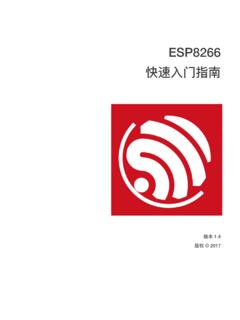Transcription of ESP32 Series - Espressif
1 ESP32 SeriesDatasheetIncluding: ESP32 -D0 WDESP32-D0 WDQ6 ESP32 -D2 WDESP32-S0 WDVersion SystemsCopyright This GuideThis document provides the specifications of ESP32 family of HistoryFor any changes to this document over time, please refer to thelast Change NotificationEspressif provides email notifications to keep customers updated on changes to technical documentation. Pleasesubscribe certificates for Espressif products and Copyright NoticeInformation in this document, including URL references, is subject to change without notice.
2 THIS DOCUMENT ISPROVIDED AS IS WITH NO WARRANTIES WHATSOEVER, INCLUDING ANY WARRANTY OF MERCHANTABIL-ITY, NON-INFRINGEMENT, FITNESS FOR ANY PARTICULAR PURPOSE, OR ANY WARRANTY OTHERWISEARISING OUT OF ANY PROPOSAL, SPECIFICATION OR liability, including liability for infringement of any proprietary rights, relating to use of information in this docu-ment is disclaimed. No licenses express or implied, by estoppel or otherwise, to any intellectual property rightsare granted herein. The Wi-Fi Alliance Member logo is a trademark of the Wi-Fi Alliance.
3 The Bluetooth logo is aregistered trademark of Bluetooth trade names, trademarks and registered trademarks mentioned in this document are property of their respectiveowners, and are hereby 2018 Espressif Inc. All rights Featured Ultra-Low-Power Complete Integration Wi-Fi Key BT Key MCU and Advanced CPU and Clocks and Advanced Peripheral Applications (A Non-exhaustive List) Block Diagram52 Pin Pin Pin Power Strapping Pins113 Functional CPU and Internal External Flash and Memory Timers and 64-bit Watchdog System CPU RTC Audio PLL GHz GHz Clock Wi-Fi Radio and Wi-Fi Bluetooth Radio and Bluetooth Bluetooth Bluetooth Link RTC and Low-Power Management204 Peripherals and Descriptions of Peripherals and General Purpose Input / Output Interface (GPIO) Analog-to-Digital Converter (ADC)
4 Hall Digital-to-Analog Converter (DAC) Touch Ultra-Lower-Power Ethernet MAC SD/SDIO/MMC Host SDIO/SPI Slave Universal Asynchronous Receiver Transmitter (UART) I C I S Infrared Remote Pulse Pulse Width Modulation (PWM) LED Serial Peripheral Interface (SPI) Peripheral Pin Configurations275 Electrical Absolute Maximum Recommended Operating DC Characteristics ( V, 25 C) Reliability RF Power-Consumption Wi-Fi Bluetooth Receiver Basic Data Transmitter Basic Data Receiver Enhanced Data Transmitter Enhanced Data Bluetooth LE Transmitter376 Package Information387 Part Number and Ordering Information398 Learning Must-Read Must-Have Resources40 Appendix A ESP32 Pin Notes on ESP32 Pin IO_MUX48 Revision History50 List of Tables1 Pin Description72 Description of ESP32 Power-up and Reset Timing Parameters103 Strapping Pins114 Memory and
5 Peripheral Mapping145 Power Consumption by Power Modes206 ADC Characteristics227 ADC Calibration Results228 Capacitive-Sensing GPIOs Available on ESP32239 Peripheral Pin Configurations2710 Absolute Maximum Ratings3211 Recommended Operating Conditions3212 DC Characteristics ( V, 25 C)3313 Reliability Qualifications3314 RF Power-Consumption Specifications3415 Wi-Fi Radio Characteristics3416 Receiver Characteristics Basic Data Rate3517 Transmitter Characteristics Basic Data Rate3518 Receiver Characteristics Enhanced Data Rate3619 Transmitter Characteristics Enhanced Data Rate3620 Receiver Characteristics BLE3721 Transmitter Characteristics BLE3722 ESP32 Ordering Information3923 Notes on ESP32 Pin Lists4124 GPIO_Matrix4325 Ethernet_MAC48 List of Figures1 Functional Block
6 Diagram52 ESP32 Pin Layout (QFN 6*6, Top View)63 ESP32 Pin Layout (QFN 5*5, Top View)74 ESP32 Power Scheme95 ESP32 Power-up and Reset Timing106 Address Mapping Structure137 QFN48 (6x6 mm) Package388 QFN48 (5x5 mm) Package389 ESP32 Part Number391. is a single GHz Wi-Fi-and-Bluetooth combo chip designed with the TSMC ultra-low-power 40 nmtechnology. It is designed to achieve the best power and RF performance, showing robustness, versatility andreliability in a wide variety of applications and power ESP32 Series of chips includes ESP32 -D0 WDQ6, ESP32 -D0WD, ESP32 -D2WD, and ESP32 -S0WD.
7 Fordetails on part numbers and ordering information, please refer toPart Number and Ordering SolutionESP32 is designed for mobile, wearable electronics, and Internet-of-Things (IoT) applications. It features all thestate-of-the-art characteristics of low-power chips, including fine-grained clock gating, multiple power modes, anddynamic power scaling. For instance, in a low-power IoT sensor hub application scenario, ESP32 is woken upperiodically and only when a specified condition is detected. Low-duty cycle is used to minimize the amount ofenergy that the chip expends.
8 The output of the power amplifier is also adjustable, thus contributing to an optimaltrade-off between communication range, data rate and power :For more information, refer to and Low-Power Integration SolutionESP32 is a highly-integrated solution for Wi-Fi-and-Bluetooth IoT applications, with around 20 external com-ponents. ESP32 integrates an antenna switch, RF balun , power amplifier, low-noise receive amplifier, filters,and power management modules. As such, the entire solution occupies minimal Printed Circuit Board (PCB) uses CMOS for single-chip fully-integrated radio and baseband, while also integrating advanced calibrationcircuitries that allow the solution to remove external circuit imperfections or adjust to changes in external condi-tions.
9 As such, the mass production of ESP32 solutions does not require expensive and specialized Wi-Fi Key Features b/g/n n ( GHz), up to 150 Mbps WMM TX/RX A-MPDU, RX A-MSDU Immediate Block ACK Defragmentation Automatic Beacon monitoring (hardware TSF) 4 virtual Wi-Fi interfacesEspressif Systems1 ESP32 Datasheet Overview Simultaneous support for Infrastructure Station, SoftAP, and Promiscuous modesNote that when ESP32 is in Station mode, performing a scan, the SoftAP channel will be changed. Antenna diversityNote.
10 For more information, please refer to Key Features Compliant with Bluetooth BR/EDR and BLE specifications Class-1, class-2 and class-3 transmitter without external power amplifier Enhanced Power Control +12 dBm transmitting power NZIF receiver with 97 dBm BLE sensitivity Adaptive Frequency Hopping (AFH) Standard HCI based on SDIO/SPI/UART High-speed UART HCI, up to 4 Mbps Bluetooth BR/EDR BLE dual mode controller Synchronous Connection-Oriented/Extended (SCO/eSCO) CVSD and SBC for audio codec Bluetooth Piconet and Scatternet Multi-connections in Classic BT and BLE Simultaneous advertising and and Advanced and Memory Xtensa single-/dual-core 32-bit LX6 microprocessor(s), up to 600 MIPS (200 MIPS for ESP32 -S0WD, 400 MIPS for ESP32 -D2WD)









